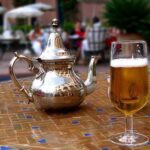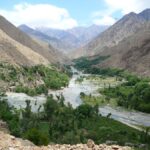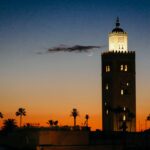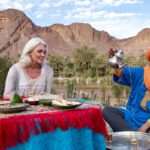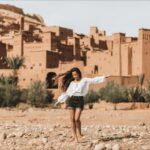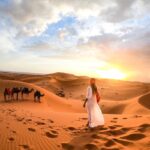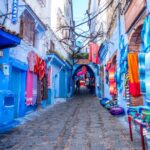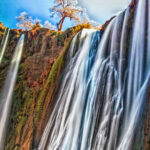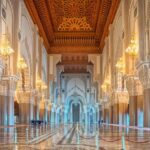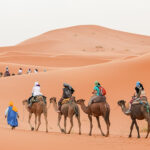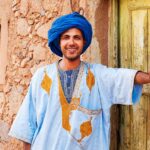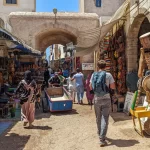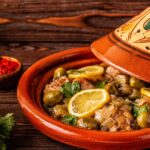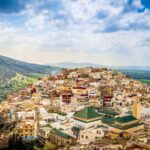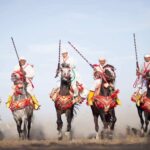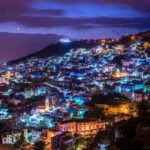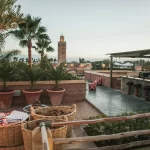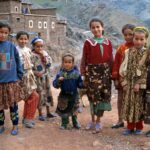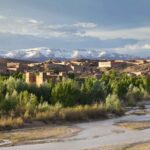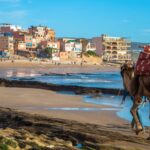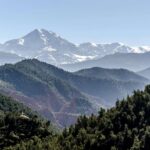Nestled amidst the majestic landscapes of Morocco and echoing through the winds of North Africa is a culture steeped in history, resilience, and vibrant traditions—the Berber culture. As we embark on this captivating journey, we aim to peel back the layers of time and immerse ourselves in the tapestry of the indigenous Berber tribe, uncovering the unique stories etched into the very fabric of Morocco’s rich heritage.
Imagine standing at the crossroads of ancient history and modern influence, where the echoes of Berber chants mingle with the bustling markets of Marrakech and where the timeless Atlas Mountains cradle the secrets of a people who have thrived for centuries. This blog post is not just a travelogue; it’s an invitation to a cultural odyssey, an exploration that transcends the superficial and ventures into the heart of the Berber way of life.
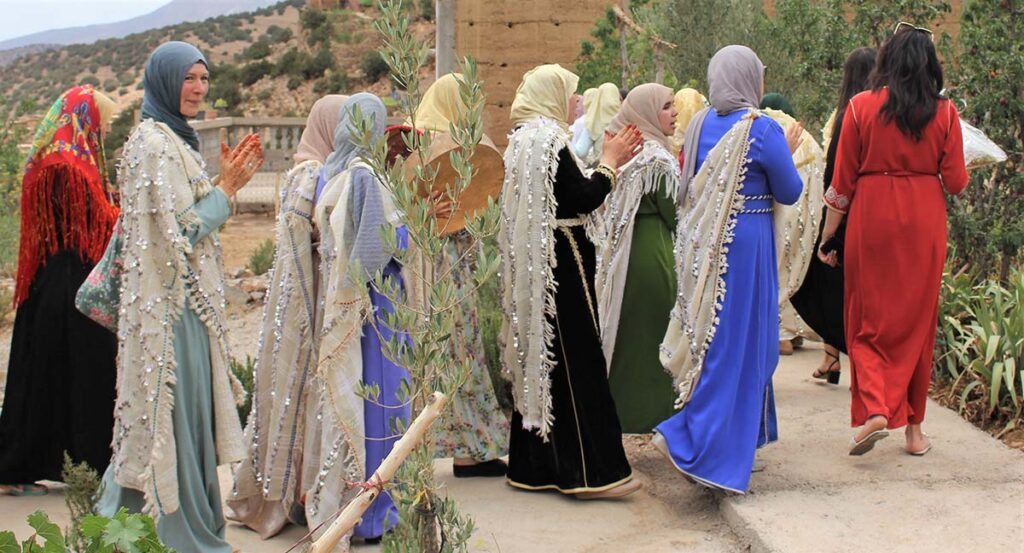
Prepare to be captivated by the intricate dance of colors in traditional Berber clothing, resonating with the vibrancy of their festivals and celebrations. Picture the silent conversations within the walls of Berber architecture, each structure telling tales of resilience against the shifting sands of time. Join us as we savor the flavors of Berber cuisine, seasoned with the richness of local ingredients and culinary traditions.
Beyond the picturesque landscapes, we delve into the very essence of Berber identity—its language, arts, and spiritual beliefs. This blog post is more than a documentation of facts; it’s an attempt to bridge the gap between past and present, to understand how the Berber people navigate the challenges of the modern world while fiercely holding onto the threads of their ancient heritage.
So, fasten your seatbelts, fellow explorers, for we are about to embark on an odyssey that transcends geographical boundaries and cultural frontiers. Let the tales of the Berber culture unfold before your eyes, weaving a narrative that echoes through the valleys and deserts of Morocco, painting a vivid portrait of North Africa’s enduring indigenous tribe. Welcome to the captivating world of the Berbers, where each step is a dance, each word a melody, and each moment an encounter with a living history.
Table of contents
- Ancient Origins and Migration Patterns of the Berber Tribes: Unveiling Centuries of Wanderlust
- Significant Historical Events Shaping the Berber Culture: Echoes of Triumphs and Challenges
- Traditional Berber Cuisine: A Culinary Adventure Unveiling the Rich Tapestry of Flavors
- Traditional Berber Clothing: A Sartorial Odyssey Through Time and Terrain
- Berber Architecture: Where Tradition Meets Terrain in a Timeless Dance
- Cultural Festivals and Celebrations: Reveling in the Rich Tapestry of Berber Traditions
- Berber Arts and Crafts: Masterpieces Woven from Heritage and Identity
- Geography of Morocco and North Africa: Shaping the Tapestry of Berber Life
- Berber Nomadic Lifestyle: Echoes of the Past, Resilience in the Present
- Berber Music and Dance: Rhythmic Tales from the Atlas Mountains to the Sahara Sands
- The Role of Women in Berber Society: Navigating Traditions and Empowerment
- Berber Religion and Spirituality: Interweaving Traditions and the Islamic Tapestry
- Berber Agriculture and Livelihoods: Cultivating Tradition Amidst Modernization
- Berber Tribes and Clans: A Mosaic of Cultural Diversity
- Preservation of Berber Heritage: Nurturing Roots, Sowing Seeds of Cultural Continuity
Ancient Origins and Migration Patterns of the Berber Tribes: Unveiling Centuries of Wanderlust
The Berber people, also known as the Amazigh, are the indigenous inhabitants of North Africa, their roots stretching deep into the annals of history. As we embark on the historical voyage of the Berber tribes, we find ourselves tracing the footsteps of a people whose origins are intertwined with the very fabric of the continent.
The tale begins in the mists of antiquity, where the Berber tribes emerge as some of the earliest inhabitants of North Africa. Archaeological evidence hints at their presence dating back thousands of years, with origins as diverse as the rugged landscapes they called home. From the Atlas Mountains to the Sahara Desert, the Berbers established a profound connection with the diverse terrains that shaped their unique identity.
Centuries before the rise of empires and kingdoms, the Berber people thrived as nomadic communities, navigating the vast expanses of North Africa. Their migratory patterns were not mere wanderings; they were a testament to adaptability and resilience, adapting to the shifting sands and changing climates with an innate understanding of their surroundings.
Yet, the story of the Berbers is not confined to the margins of history; it has been inscribed in the grand narratives of empires and civilizations. From the Phoenician and Roman interactions to the Islamic conquests, the Berber tribes were both actors and witnesses, leaving an indelible mark on the pages of time.
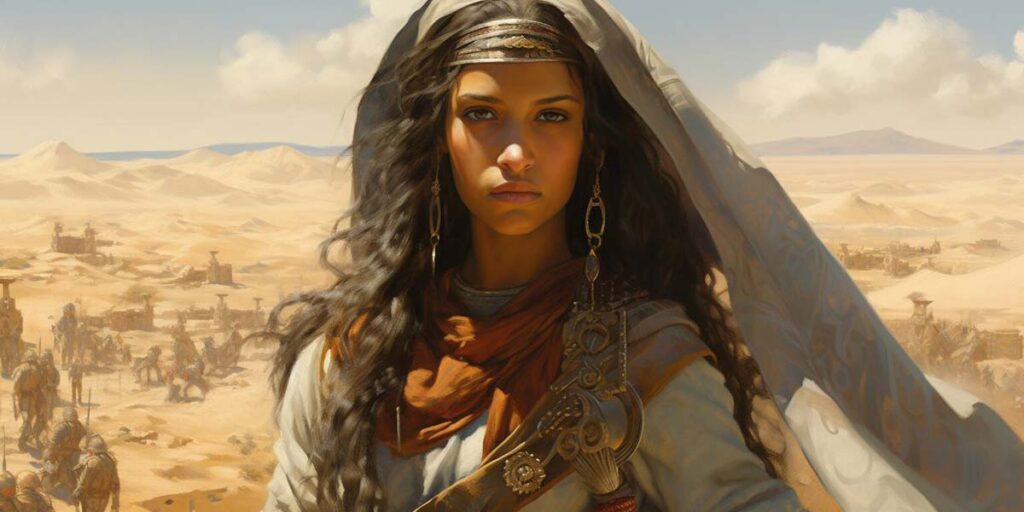
Significant Historical Events Shaping the Berber Culture: Echoes of Triumphs and Challenges
The Berber people have weathered the storms of history, their resilience evident in the face of conquests, cultural exchanges, and the ebb and flow of civilizations. The ancient Berber kingdoms, such as the Ghomara and the Mauri, stood as a testament to their capacity to form organized societies and engage in commerce and trade.
As the tides of history turned, the Berbers found themselves at the crossroads of multiple influences. The Arab expansion in the 7th century brought Islam to North Africa, forever altering the cultural landscape. The Berbers embraced Islam, integrating it into their existing belief systems, creating a unique amalgamation of spiritual practices that endured through the centuries.
The Almoravid and Almohad dynasties witnessed the rise of powerful Berber-led empires that extended their influence beyond the Maghreb, leaving an indelible mark on the history of medieval North Africa. However, the challenges were manifold, with colonial powers carving up the region during the 19th and 20th centuries, leaving a legacy that the Berber people grapple with in the modern era.
The Berber culture evolved in the shadow of these triumphs and challenges, enriched by a mosaic of influences that define its complexity. Join us as we delve deeper into the fascinating narrative of the Berber people, uncovering the layers of history that have shaped their identity and continue to resonate in the cultural tapestry of Morocco and beyond.
Traditional Berber Cuisine: A Culinary Adventure Unveiling the Rich Tapestry of Flavors
Embark on a gastronomic journey through the sun-kissed landscapes of North Africa, where the vibrant and flavorful world of Berber cuisine beckons with open arms. Beyond the bustling markets of Marrakech and the timeless Atlas Mountains lies a culinary heritage as diverse and rich as the landscapes that have nurtured it for centuries.
The Essence of Berber Cuisine:
Berber cuisine’s heart lies in celebrating local ingredients and time-honored culinary techniques. Picture aromatic spices, sun-ripened olives, and hand-kneaded Couscous, all coming together to create a symphony of flavors that dance on the taste buds. Berber cuisine is not merely a meal but a sensory experience reflecting the connection between the people and the land.
Signature Dishes and Recipes:
Prepare to be enticed by the iconic dishes that grace the Berber dining table—from the hearty and comforting Tagine, slow-cooked to perfection, to the fragrant Couscous. This artful creation transcends mere sustenance. Each dish tells a story of tradition and craftsmanship. Discover the secrets behind the preparation of timeless recipes passed down through generations, a culinary heritage preserved with pride.
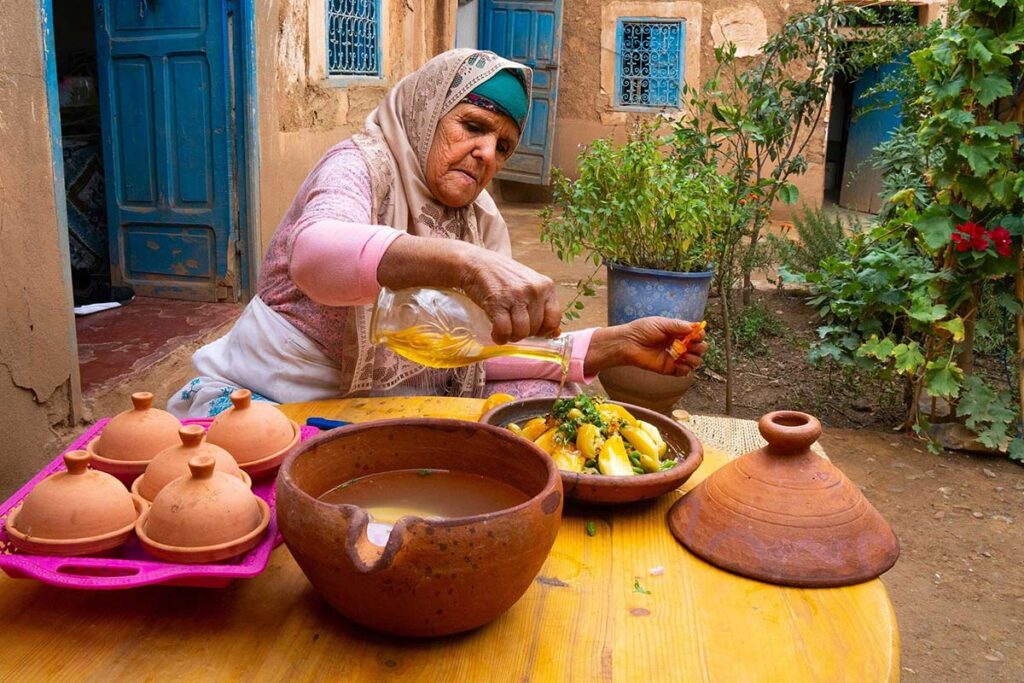
Regional Influences and Diversity:
Berber cuisine is a mosaic of regional influences, with each area contributing its unique twist to the culinary narrative. Coastal regions boast an abundance of seafood, while the mountainous interiors showcase the mastery of preserving meats and crafting robust stews. Explore the nuances that make Berber cuisine a dynamic and ever-evolving expression of the local terroir.
Cooking Methods and Culinary Traditions:
Uncover the ancient cooking methods that have stood the test of time. From the communal bread-baking ovens to the art of slow cooking over open flames, Berber culinary traditions are deeply rooted in the daily lives of its people. Join us as we lift the lid on the Tagine. This vessel has become synonymous with Berber cooking. It delves into the artistry of preserving fruits and vegetables through sun-drying.
The Significance of Ingredients:
Beyond the delectable flavors, each ingredient in Berber cuisine carries a cultural significance. From the versatile Argan oil sourced from the ancient Argan trees to the aromatic blend of spices that reflects the crossroads of historical trade routes, the ingredients tell a tale of a people deeply connected to the land.
Join us as we traverse the culinary landscapes of the Berber people, where each meal is a story, each recipe a chapter in the epic narrative of a vibrant and enduring culture. From the first sip of mint tea to the last bite of honey-soaked pastries, let the flavors of Berber cuisine and Moroccan culinary traditions transport you to a world where every meal celebrates tradition, community, and the art of savoring life.
Traditional Berber Clothing: A Sartorial Odyssey Through Time and Terrain
Step into the kaleidoscopic world of Berber communities, where the threads of tradition weave an intricate tapestry of clothing that adorns the body and narrates stories of heritage, identity, and the diverse landscapes that shape the Moroccan way of life.
Embarking on a Fashionable Journey:
In the vibrant markets of Morocco, traditional Berber clothing unfolds like a living history book. The attire worn by Berber communities reflects the practical needs of daily life and the cultural and aesthetic expressions that have evolved over centuries. Join us as we embark on a fashionable journey, unraveling the layers of cloth that signify more than just garments.
Garments as Cultural Artifacts:
Berber clothing serves as a canvas for cultural expression. It is adorned with intricate patterns, vibrant colors, and symbolic motifs that speak to the wearer’s identity, social status, and even the Berber tribe they belong to. Each garment, from headscarves to robes, is a masterpiece that tells a story of craftsmanship and cultural pride.
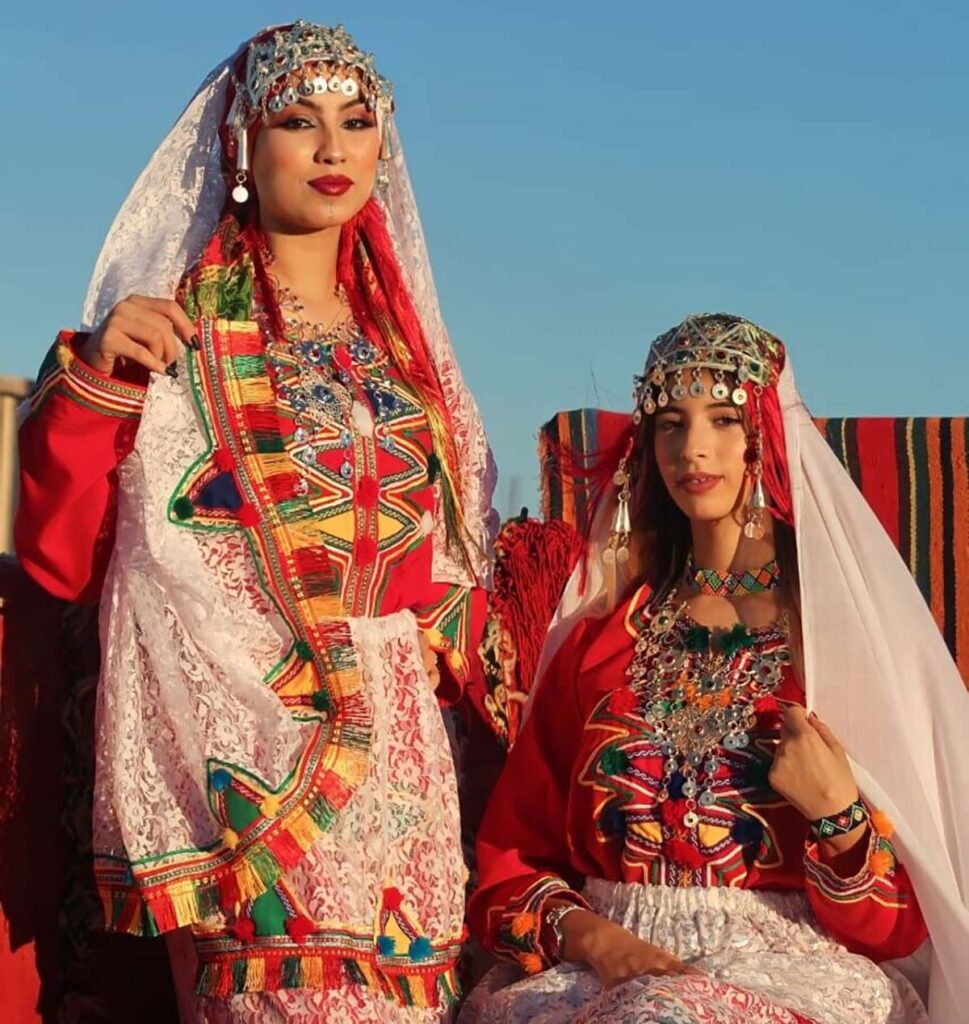
Variations Across Different Regions:
The Berber communities are as diverse as the landscapes they inhabit, and this diversity is beautifully mirrored in the variations of traditional clothing. Each locale contributes uniquely flair to the sartorial heritage, from the coastal regions to the mountainous interiors. Discover how environmental factors, historical influences, and the spirit of each region manifest in the clothing styles worn by Berber men and women.
The Language of Colors and Patterns:
Berber clothing communicates through a language of colors and patterns, each hue and design holding its significance. Explore the earthy tones of the Sahara, the vivid blues of coastal villages, and the rich reds of the Atlas Mountains. Dive into the symbolism behind geometric patterns, floral motifs, and the meticulous embroidery that transforms each piece into a wearable work of art.
Functional Elegance:
Beyond aesthetics, Berber clothing is a testament to functional elegance. The garments are designed to provide comfort, protection, and ease of movement while adapting to harsh climates and varied terrains. Witness the ingenious use of materials like wool, leather, and cotton, tailored to withstand the elements while exuding timeless style.
Preserving Heritage in the Modern Era:
As modernity sweeps through Morocco, traditional Berber clothing faces the challenge of evolving while preserving its essence. Discover how communities navigate the delicate balance between honoring their heritage and embracing contemporary fashion trends.
Join us as we unravel the threads of tradition, exploring the diverse and captivating world of traditional Berber clothing. From the nomadic spirit captured in each weave to the cultural pride stitched into every seam, the garments of Berber communities tell a story that transcends time and geography, inviting us to appreciate the artistry and symbolism woven into the very fabric of their existence.
Berber Architecture: Where Tradition Meets Terrain in a Timeless Dance
In the undulating landscapes of North Africa, the Berber people have forged a harmonious alliance between architecture and the natural world. From the cradle of the Atlas Mountains to the sun-kissed expanses of the Sahara, traditional Berber architectural styles stand as living testaments to a deep connection with the land. Join us as we embark on an architectural journey, where homes and communal buildings become not just shelters but expressions of a cultural identity intertwined with the breathtaking local landscapes.
Traditional Berber Homes: A Symphony of Simplicity and Elegance:
Wander through Berber villages, and you’ll encounter homes that seem to have sprouted from the earth they stand on. Berber houses, often constructed using locally sourced materials such as clay, stone, and wood, are characterized by their low, earthy profiles. Dwellings with flat roofs adorned with vibrant rugs and textiles dot the landscapes, mirroring the simplicity of life and the people’s resilience.
Communal Buildings: Gathering Spaces Woven into the Fabric of Communities:
The communal spirit of Berber life extends to the very architecture that binds communities together. Communal buildings, whether mosques, granaries, or gathering spaces, reflect a communal ethos. Marvel at the intricate geometric patterns adorning mosque facades or the practical elegance of communal granaries, each structure becoming a physical embodiment of shared values and collective identity.
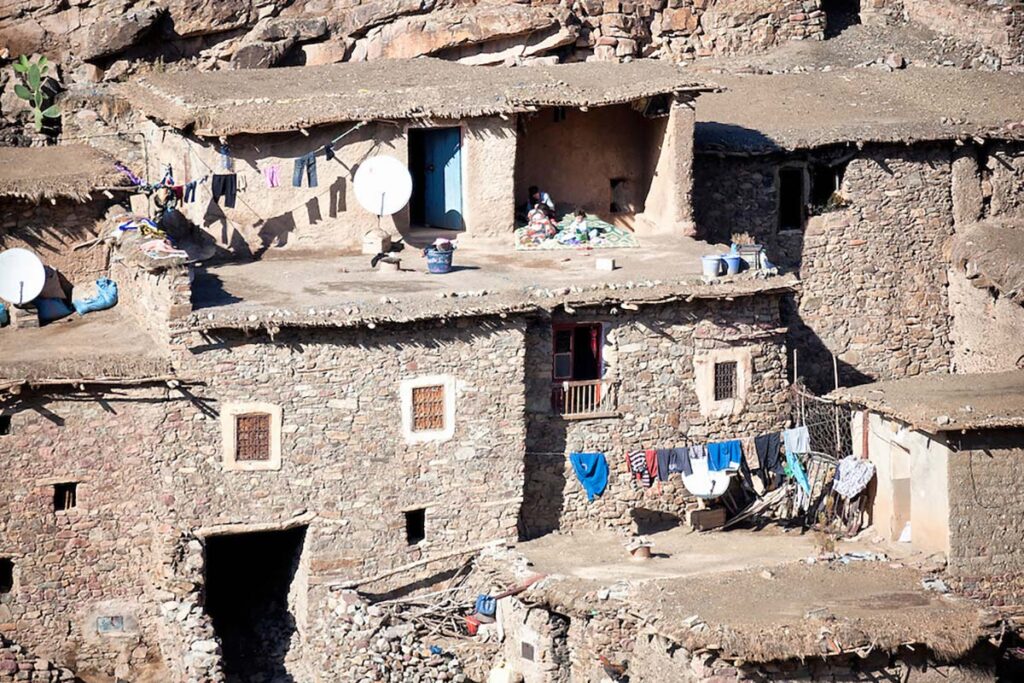
Integration with Local Landscapes: Nature as Architectural Muse:
Berber architecture is not an imposition on the landscape but a seamless integration with the natural surroundings. Experience the synergy between buildings and terrain, where homes seem to emerge organically from the hillsides, blending with the contours of the land. Berber architects leverage the inherent beauty of their surroundings, creating structures that complement, rather than conquer, the landscape.
Adapting to Climate and Terrain: Ingenuity in Design:
Berber architects showcase an innate understanding of the harsh climates and varied terrains of North Africa. The design of homes reflects a keen awareness of temperature extremes, with thick walls providing insulation against the heat and cold. The flat roofs of many Berber dwellings serve not just as living spaces but also as vantage points to gaze upon the vast expanse of the surrounding landscapes.
Artistry in Mud and Stone: Craftsmanship Beyond Utility:
Berber architecture is a canvas for the skilled hands of local craftsmen. Marvel at the artistry etched into mud-brick walls, the geometric patterns that adorn doorways, and the poetic simplicity of arches and niches. Each building tells a story of craftsmanship passed down through generations, where functionality merges seamlessly with aesthetic expression.
Preserving Heritage in the Modern Era: Balancing Tradition and Progress:
As the modern world encroaches, Berber communities grapple with preserving their architectural heritage while adapting to contemporary needs. Explore how architectural traditions evolve to accommodate changing lifestyles, all while safeguarding the unique character that defines Berber dwellings.
Embark with us on a journey through the landscapes of Berber architecture, where the homes and communal buildings are:
• Not just structures but living reflections of a people deeply rooted in the earth.
• Crafting a legacy that stands as an architectural ode to tradition resilience.
• The boundless beauty of the Maghreb.
Cultural Festivals and Celebrations: Reveling in the Rich Tapestry of Berber Traditions
In the heartlands of North Africa, the Berber people enliven the landscape with a kaleidoscope of festivals and celebrations, each event weaving together threads of history, spirituality, and community. Join us on a journey through the rhythmic beats and vibrant colors of Berber cultural festivities, where ancient traditions converge with the present, creating a tapestry of celebration that transcends time.
Overview of Major Berber Festivals: A Calendar of Celebration:
Berber festivals form a rhythmic calendar, punctuating the seasons with joyous gatherings and spirited expressions of cultural identity. From the lively dance of spring festivals like Imilchil’s Souk Aamur to the solemnity of Yennayer, the Berber New Year celebrated in January, each festival reflects Berber communities’ diversity and connection to the natural cycles of life.
Rituals and Traditions: Choreography of Cultural Expression:
Step into the heart of Berber festivals, and you’ll witness a choreography of rituals and traditions that have endured for centuries. Immerse yourself in the intricate dance of Ahouach, a traditional dance form where women clad in vibrant attire move to the beat of drums, echoing the rhythm of collective joy. Experience the solemnity of ceremonies that mark agricultural milestones, where the sowing and harvesting of crops become sacred acts intertwined with spiritual significance.
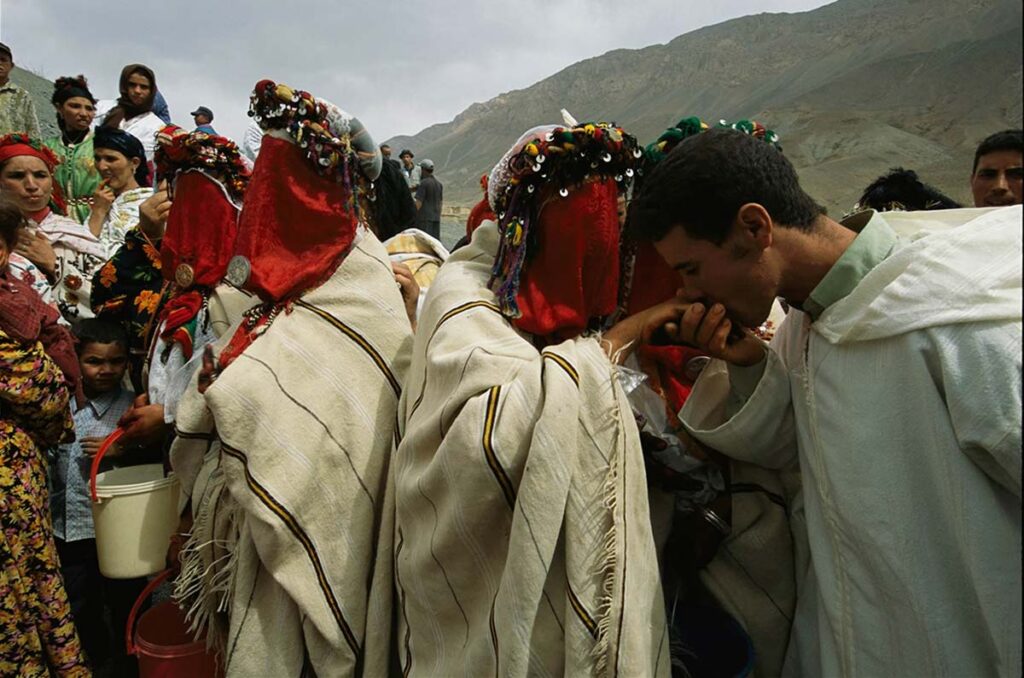
The Cultural Significance: A Communal Bond Woven in Festivities:
Berber festivals are not mere spectacles but manifestations of a deep-seated communal spirit. Through shared rituals and festivities, Berber communities forge a bond that transcends familial ties, creating a collective identity that is strengthened with each dance, song, and communal feast. These celebrations become a living testament to the resilience of Berber culture, celebrating the endurance of traditions through the ebb and flow of time.
Imilchil Wedding Festival: A Uniquely Berber Celebration:
The Imilchil Wedding Festival is a highlight in the Berber cultural calendar. This festival, known as “Souk Aamur,” brings together young men and women from different tribes to celebrate love, courtship, and the forging of marital bonds. Witness the exchange of vows, the vibrant display of traditional wedding attire, and the pulsating energy that fills the air as communities come together in a jubilant expression of unity.
Yennayer: The Berber New Year Celebration: Renewal and Reflection:
Yennayer marks the Berber New Year, a time of renewal and reflection. As communities gather to welcome the new year, traditional foods such as Couscous and special breads take center stage. The rituals associated with Yennayer reflect a deep connection to agricultural cycles, symbolizing the hope for a prosperous year ahead and the endurance of Berber cultural heritage.
Join us amid the festivities, where the air is filled with the aroma of traditional foods, the rhythm of music and dance, and the collective heartbeat of a people celebrating the moment and the timeless spirit of Berber culture. In the tapestry of these celebrations, witness the resilience, diversity, and enduring traditions that define the Berber way of life vibrancy.
Berber Arts and Crafts: Masterpieces Woven from Heritage and Identity
In the mountainous landscapes and sun-kissed oases of North Africa, the Berber people elevate craftsmanship to an art form, creating masterpieces that adorn their homes and bodies and serve as vibrant expressions of cultural identity. Join us on a journey through the exquisite world of Berber arts and crafts, where every thread, every pottery shard, and every bead tells a story that transcends time.
Traditional Berber Weaving: Threads of Heritage and Skill:
Berber weaving is a testament to the meticulous skill and artistry embedded in the hands of the craftswomen. Explore the vibrant tapestries, rugs, and textiles adorned with intricate geometric patterns and symbolic motifs. Each weave reflects artistic prowess and a deep connection to the surrounding landscapes, mirroring the colors of the earth and the sky. Witness the rhythm of looms, where tradition is preserved with each shuttle pass, ensuring that every textile is a living testament to Berber heritage.
Pottery: Clay as Canvas, Earth as Inspiration:
In the hands of Berber artisans, clay transforms into vessels of breathtaking beauty. Berber pottery, whether Tagines, plates, or decorative items, reflects a fusion of utility and art. Delve into the world of pottery adorned with intricate designs, where each curve and contour tells a story of ancient craftsmanship. The earthy tones and patterns echo the landscapes that inspire them, grounding the art in the soil from which it springs.
Jewelry: Adornments of Identity and Symbolism:
Berber jewelry is not merely an embellishment but a language of symbols, a code of identity, social status, and spirituality. Explore the silver and beadwork adorning necks, wrists, and ears, each piece a manifestation of cultural pride. Symbols such as Fatima’s Hand and Horus’s Eye convey protective energies. At the same time, enamelwork reflects the vibrant palette of Berber traditions. Every piece of jewelry is a wearable piece of heritage, a connection to the ancestral spirits and the symbols that bind generations.
Art as Identity: The Role of Creativity in Preserving Heritage:
Berber arts and crafts are more than ornamental; they are vital to preserving cultural identity. Berber communities pass down stories, symbols, and traditions through creative expression to future generations. The art becomes a living archive, a visual narrative that transcends the boundaries of time, ensuring that the Berber people’s legacy is remembered and celebrated.
The Resurgence of Berber Art: Navigating Tradition and Modernity:
As the world evolves, so does Berber art. Modern artisans find innovative ways to marry traditional techniques with contemporary aesthetics, creating pieces that resonate with a global audience while retaining the essence of Berber identity. Discover how Berber art continues to evolve, adapt, and thrive in changing times.
In the hands of Berber artisans, art is not just a creation; it is a celebration of heritage, an assertion of identity, and a testament to the enduring spirit of a people whose creativity knows no bounds. Join our Marrakech walking tour to explore the galleries of Berber craftsmanship where every stroke, every stitch, and every shape unveils a masterpiece woven from the threads of history and cultural pride.
Geography of Morocco and North Africa: Shaping the Tapestry of Berber Life
The landscapes of Morocco and North Africa, with their diverse terrain and geographical features, serve as the silent architects of the Berber way of life. Join us on a journey through the geographical wonders that cradle Berber communities, influencing their daily lives and the rich tapestry of traditions that define their cultural identity.
The Atlas Mountains: Guardians of Berber Homelands:
Stretching like a majestic spine through Morocco, the Atlas Mountains are not just geographical features but integral to the Berber identity. Picture terraced fields clinging to the mountainsides, where the Berbers cultivate crops that thrive in the mountainous terrain. These rugged landscapes impact agricultural practices and shape Berber homes’ architecture, creating a harmonious blend with the natural contours of the mountains.
The Sahara Desert: A Sea of Endless Sands:
To the south, the vast expanse of Moroccan Sahara Desert unfolds—a stark yet breathtaking landscape that has played a profound role in Berber nomadic life. The desert’s influence is seen in the traditional clothing of the nomadic Berbers, designed to protect against the harsh sun and blowing sands. Nomadic Berber communities, with their camel caravans, have historically traversed this sea of sand, adapting to the challenges and treasures the desert provides.
The Coastal Regions: Where Sea Meets Shore:
The coastal regions of Morocco, where the Mediterranean Sea and the Atlantic Ocean embrace the land, bring their influence to Berber communities. Coastal villages and towns like Essaouira engage in vibrant fishing traditions, infusing Berber cuisine with a bounty of seafood. The rhythm of tides and the salty breeze leave an imprint on the lifestyle of coastal Berber communities, influencing their cuisine and cultural practices.
Oases and Valleys: Lifelines in Arid Lands:
The lush oases and fertile valleys stand as verdant jewels amid arid landscapes, offering vital sources of water and sustenance. Here, the Berbers have cultivated palm groves and tended to crops, adapting their agricultural practices to the life-giving rivers that meander through these fertile corridors. The oases become oases of water and cultural exchange as trade routes crisscross these vibrant centers.
Impact of Geography on Lifestyle and Traditions:
The geography of Morocco and North Africa is not merely a backdrop; it is an active participant in the rhythm of Berber life. The nomadic traditions of Berber communities are a direct response to the vast landscapes they traverse, where the shifting sands of the Sahara or the rocky terrain of the Atlas Mountains shape the nomadic lifestyle. Agricultural practices vary with the altitude and proximity to water sources, impacting the types of crops cultivated and the culinary traditions that emerge.
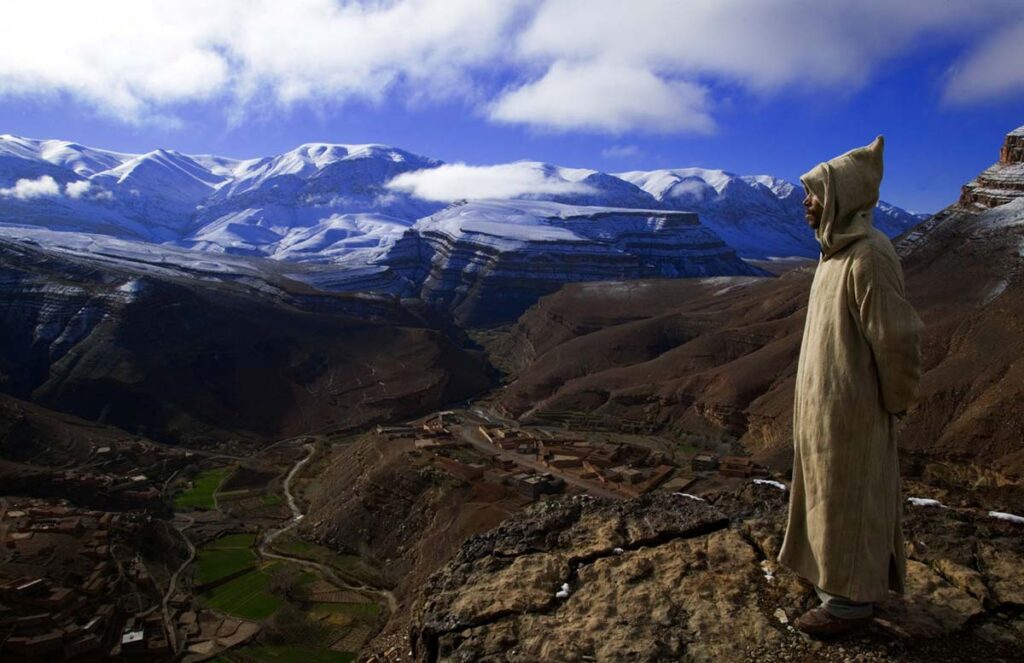
Adaptation and Resilience: Navigating the Terrain:
Berber communities are remarkably able to adapt and thrive in diverse geographical conditions. Whether scaling mountain peaks, crossing deserts, or cultivating fertile valleys, the Berber people have forged a symbiotic relationship with the land. Their lifestyle and traditions reflect not just the geographical features but also a testament to the resilience and resourcefulness required to navigate these terrains.
Embark with us on a journey through the geographical wonders that cradle Berber life, where the landscapes are not just backdrops but active participants in shaping the traditions, customs, and daily rhythms of a people deeply connected to the earth beneath their feet.
Berber Nomadic Lifestyle: Echoes of the Past, Resilience in the Present
In the vast expanses of Morocco and North Africa, the Berber nomadic lifestyle weaves a narrative of a people deeply connected to the rhythms of nature, traversing deserts, mountains, and plains in a timeless dance with the land. Join us as we delve into the traditional nomadic practices of Berber tribes, exploring their adaptation to modern changes while preserving the essence of a nomadic heritage that has endured for centuries.
Traditional Nomadic Practices: Wandering Spirits in a Changing Landscape:
Berber nomadic life is rooted in a deep understanding of the land and its resources. Picture vast caravan trails winding through the Sahara, where nomadic Berbers move with their herds in search of grazing grounds and water sources. The nomadic lifestyle extends beyond a mere means of survival; it is a way of life intricately woven with cultural traditions, familial bonds, and a profound respect for the environment.
Berber Tents: Portals to Nomadic Life:
The traditional tents of nomadic Berbers, often woven from goat hair and adorned with vibrant textiles, are not just shelters; they are portable homes that echo families’ laughter and the warmth of communal gatherings. These tents symbolize the nomadic lifestyle, providing shelter in the vast landscapes while allowing for a fluid existence that responds to the ever-changing needs of the journey.
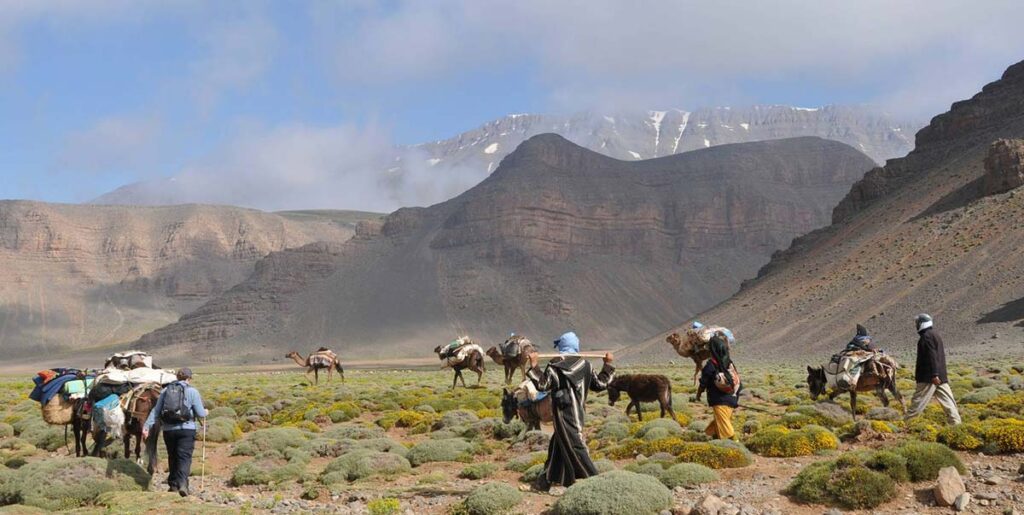
Nomadic Herding and Agriculture: Symbiosis with the Land:
Nomadic Berbers are skilled herders, navigating their flocks of sheep, goats, and camels across diverse terrains. This movement is not just a quest for sustenance but a symbiotic relationship with the land. In fertile valleys, nomadic Berbers practice seasonal agriculture, cultivating crops that sustain them during their journey. The delicate balance between herding and agriculture reflects the adaptability required to thrive in varied landscapes.
Rituals of the Nomadic Year: Celebrating Nature’s Bounty:
Nomadic Berbers mark the passage of time with rituals tied to the seasons. Imagine communal celebrations beneath the vast desert sky, where music, dance, and feasts honor the cycles of nature. These rituals are not just festivities; they are expressions of gratitude for the land’s generosity and an acknowledgment of the interdependence between nomadic communities and their surroundings.
Adaptation to Modern Changes: Navigating the Winds of Change:
As the modern world encroaches on traditional nomadic territories, Berber communities face the challenge of balancing tradition with the demands of contemporary life. Many nomadic Berbers have settled in semi-permanent dwellings, adapting to changing economic and social landscapes. The introduction of motorized vehicles, modern communication technologies, and shifts in trade patterns have influenced the nomadic way of life, challenging communities to find new paths while preserving their cultural roots.
Preservation of Nomadic Traditions: A Continuation of Heritage:
Despite the changes, Berber nomadic communities actively work to preserve their traditions. Initiatives focused on cultural education, sustainable resource management, and the revival of traditional crafts contribute to the continuity of the nomadic heritage. Berber nomads, whether settled or on the move, carry the legacy of their ancestors, ensuring that the nomadic spirit endures in the face of modernization.
Embark with us on a journey through the shifting sands and expansive horizons where the Berber nomadic lifestyle unfolds. Witness the adaptability and resilience of a people whose traditions are a living testament to the delicate dance between tradition and change. This dance resonates across the timeless landscapes of Morocco and North Africa.
Berber Music and Dance: Rhythmic Tales from the Atlas Mountains to the Sahara Sands
In the heartlands of North Africa, the sounds of traditional Berber music and the vibrant movements of dance echo through the ages, weaving tales of cultural richness and ancestral connections. Join us on a rhythmic journey through the diverse forms of Berber music and dance, exploring their unique expressions and their profound influence on the broader North African music scene.
Traditional Berber Music: Harmonies of Heritage:
Berber music, deeply rooted in the cultural fabric of North Africa, is a tapestry of harmonies and rhythms that narrate the stories of the land and its people. Traditional instruments such as the Bendir (a frame drum), the g
Guembri (a three-stringed bass lute), and the Imzad (a single-stringed bowed instrument) form the backbone of Berber musical compositions. The melodies are often characterized by modal scales and intricate ornamentations, creating a distinctive sound that resonates with the landscapes from which it emanates.
Ahwach: The Rhythmic Heartbeat of Berber Gatherings:
Ahwach is a traditional Berber music and dance form that serves as a communal celebration. Picture a circle of performers clad in vibrant attire, the rhythmic beat of the Bendir setting the pace for dancers who move with grace and precision. Ahwach performances are not merely entertainment; they are an expression of communal identity and a means of preserving the oral traditions passed down through generations.
Imzad Music: Soulful Strings in the Sahara:
Originating from the Tuareg people of the Sahara, the imzad is both an instrument and a genre of music. Played by talented musicians, often women, the imzad emits soulful melodies that resonate with the vast desert landscapes. The poetic lyrics convey tales of love, hardship, and the timeless connection between the nomadic Berbers and their environment.
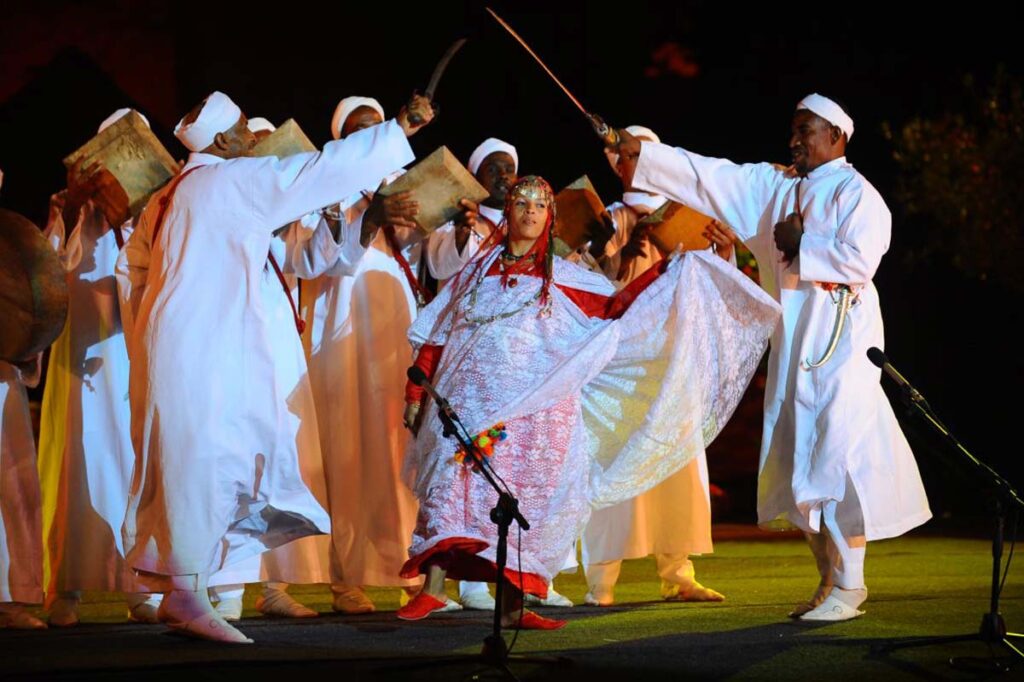
Influence of Berber Music on North African Traditions:
The influence of Berber music extends beyond the boundaries of Berber communities, permeating the broader North African music scene. Elements of Berber melodies, rhythms, and instruments have seamlessly integrated with the diverse musical traditions of the region. From the lively sounds of Moroccan Gnawa music to the fusion of Berber and Arabic musical styles, Berber music is a dynamic force that enriches and diversifies the North African sonic landscape.
Modern Expressions: Fusion of Berber and Contemporary Sounds:
In contemporary times, Berber musicians continue to evolve their art, embracing modern influences while retaining the essence of their cultural heritage. Fusion genres that blend Berber rhythms with electronic beats or global musical trends have emerged, bridging traditional roots and contemporary expressions. Berber artists contribute to a global dialogue, showcasing the enduring relevance of their musical traditions.
Berber Dance: Expressive Movements in Cultural Harmony:
Like the music, Berber dance is a dynamic expression of cultural identity. Dancers, adorned in traditional attire, move with intricate footwork and gestural expressions, often telling stories of everyday life, nature, and ancestral connections. The movements are not just choreography; they are a living embodiment of the Berber way of life, celebrating the resilience and vibrancy of their cultural heritage.
Embark on a rhythmic exploration through the landscapes of Berber music and dance, where every beat, every melody, and every movement becomes a vessel for cultural storytelling. In the echoes of Berber rhythms, discover a musical journey that spans centuries, connecting the ancestral traditions of North Africa with the ever-evolving sounds of the present.
The Role of Women in Berber Society: Navigating Traditions and Empowerment
Within the rich tapestry of Berber society, women play pivotal roles that extend beyond the boundaries of households. Examining women’s historical roles and status in Berber communities unveils a nuanced narrative, showcasing resilience, cultural contributions, and an ongoing evolution towards more significant gender equity.
Historical Roles of Berber Women: Pillars of Family and Community:
In traditional Berber society, women have been foundational to the fabric of daily life. Beyond their household roles, they have actively participated in agriculture, animal husbandry, and artisanal crafts. The matrilineal aspect of Berber communities has often translated into women having a say in family matters, inheritance, and the transmission of cultural knowledge.
Nomadic Life and Women’s Contributions: A Dynamic Partnership:
In the nomadic Berber lifestyle, women are integral to the survival of their communities. Nomadic women engage in herding, manage domestic affairs, and contribute to the sustenance of their families. The tent, a symbol of the nomadic lifestyle, becomes a shared space where women maintain the household and pass down oral traditions, preserving cultural heritage.
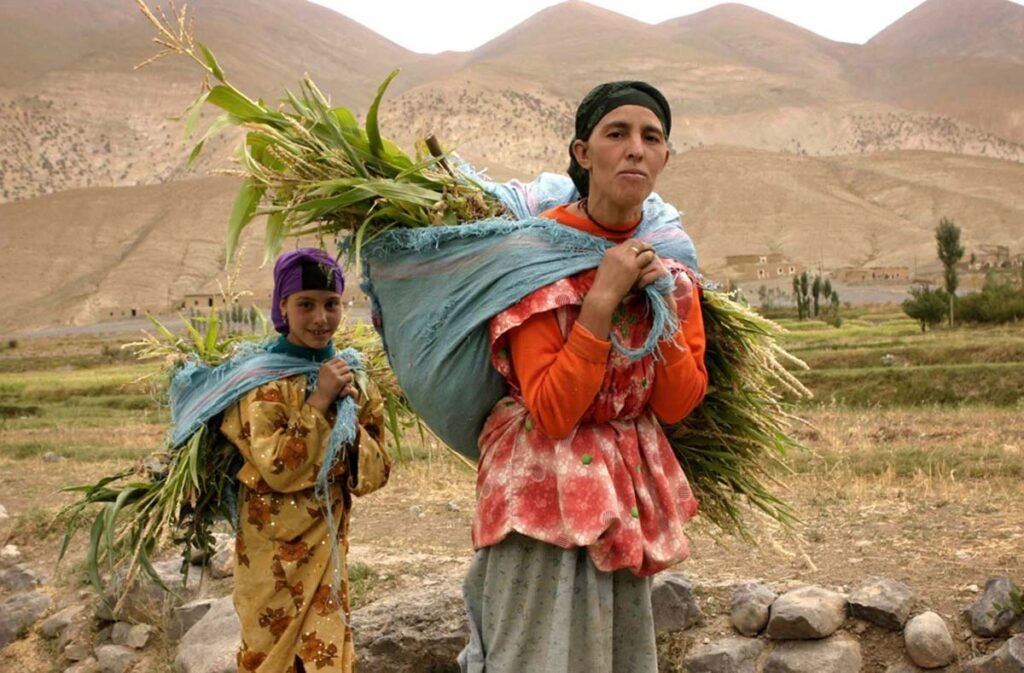
Cultural Celebrations and Women’s Participation:
Berber cultural celebrations offer a platform for women to showcase their artistic talents. Traditional music, dance, and craftwork often involve active participation from women, becoming expressions of cultural identity and communal pride. Events like Ahwach, where women play prominent roles, exemplify the dynamic contributions of women to the vibrancy of Berber traditions.
Changes in Gender Dynamics: Evolving Realities:
As the societal landscape evolves, so do gender dynamics within Berber communities. Modernization, education, and exposure to external influences have shifted traditional gender roles. While traditional expectations persist in some areas, there is a growing recognition of the need for more inclusive practices that empower women to explore diverse roles within and beyond the household.
Women’s Empowerment and Education: A Transformative Path:
Education has emerged as a powerful force in shaping the trajectory of women’s empowerment in Berber society. Increasing access to education has opened avenues for women to engage in professions beyond traditional roles. As literacy rates rise, women actively participate in civic life and advocacy and contribute to the broader socio-economic development of their communities.
Challenges and Opportunities: Navigating a Complex Landscape:
Challenges persist, and the path towards gender equality in Berber society is not without obstacles. Traditional norms, economic disparities, and regional variations can influence the opportunities available to women. However, women navigate these challenges resiliently, contributing to the ongoing dialogue around women’s rights and empowerment.
Cultural Preservation and Gender Equity: A Harmonious Coexistence:
The preservation of Berber culture need not be at odds with gender equity. Communities are finding ways to celebrate and protect their cultural heritage while fostering an environment that allows women to explore new roles and opportunities. The coexistence of cultural preservation and gender equity reflects the adaptability and resilience of Berber society.
Embark on a journey through women’s roles in Berber society, where tradition and transformation intersect. The evolving status of women reflects not only the complexities within Berber communities but also the potential for a more inclusive and equitable future, where the contributions of women are celebrated as integral to the vibrant tapestry of Berber life.
Berber Religion and Spirituality: Interweaving Traditions and the Islamic Tapestry
In the heartlands of North Africa, the Berber people have woven a rich tapestry of religious and spiritual beliefs, where ancient traditions dance alongside the tenets of Islam. Examining the traditional beliefs and practices of the Berber people offers a glimpse into the intricate interplay between ancestral spirituality and the Islamic faith.
Traditional Berber Spirituality: A Tapestry of Ancestral Beliefs:
Traditional Berber spirituality is deeply rooted in the natural world, with a profound connection to the landscapes they inhabit. Elements of animism, ancestor veneration, and reverence for natural phenomena shape the spiritual practices of Berber communities. Mountains, rivers, and sacred sites become conduits to the divine, reflecting a belief system where the spiritual and earthly realms coalesce.
Amazigh Animism: Spirits in Nature:
Central to Berber spirituality is the belief in spirits residing in natural elements. Mountains, trees, and bodies of water are often considered sacred, embodying spiritual forces. The Amazigh people, encompassing many Berber communities, have traditionally believed in the presence of jinn, or supernatural beings, residing in the natural world. Rituals and offerings are made to honor these spirits and seek their protection.
Ancestor Veneration: Connecting Past and Present:
Berber communities maintain a solid connection to their ancestors, viewing them as intermediaries between the living and the divine. Ancestor veneration involves rituals, storytelling, and commemorative practices that honor the wisdom and guidance of those who came before. The spirits of ancestors are believed to offer protection and blessings to their descendants.
Islamic Influence: The Arrival of a New Spiritual Horizon:
The advent of Islam in North Africa, beginning in the 7th century, introduced a new spiritual horizon to Berber communities. Islam brought monotheism, a structured religious framework, and a new set of practices to the region. The Quran and the teachings of Prophet Muhammad became central to the religious life of Berbers, coexisting with traditional spiritual beliefs.
Syncretism: A Harmonious Blend of Faiths:
The interaction between traditional Berber beliefs and Islam has resulted in a syncretic approach to spirituality. Berber communities often practice Islam alongside traditional rituals, creating a unique fusion of faiths. This syncretism is characterized by a fluidity that allows individuals to draw from both belief systems, adapting practices to suit their cultural and spiritual needs.
Maraboutism: Holy Figures in Berber Islam:
Marabouts, or holy figures, play a significant role in Berber Islam. These revered individuals are often considered spiritual guides, healers, and intermediaries between the divine and the earthly realms. Marabout shrines dot the landscapes, serving as places of pilgrimage and reflection where individuals seek blessings and guidance.
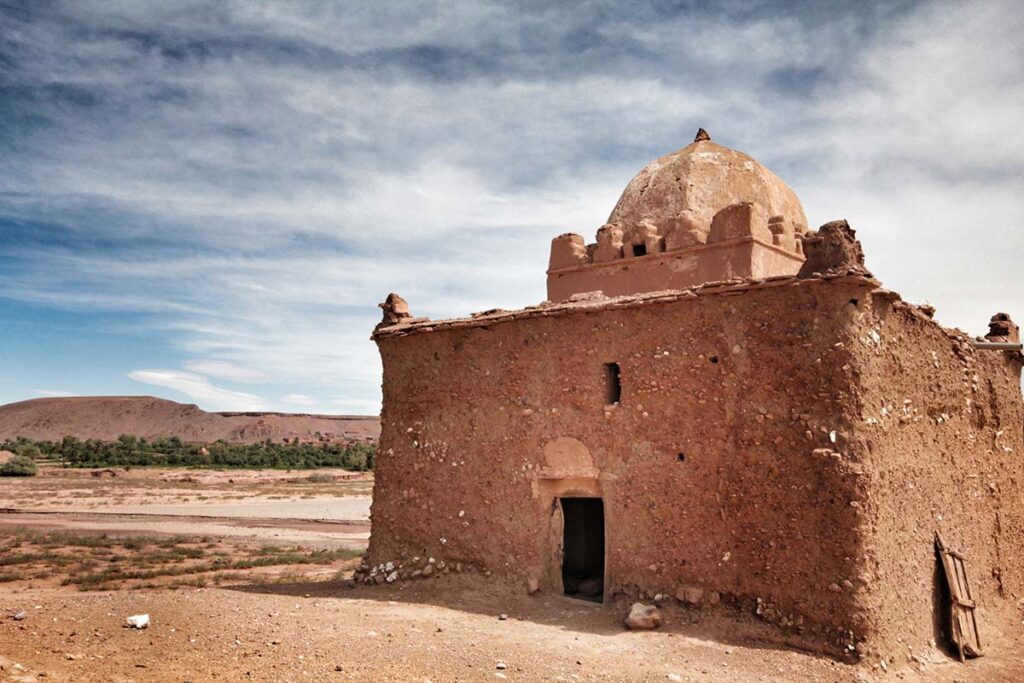
Cultural Festivals: Bridging the Spiritual Divide:
Cultural festivals in Berber communities serve as occasions where traditional spirituality and Islamic practices converge. Celebrations often include a blend of music, dance, and rituals that pay homage to both ancestral spirits and Islamic traditions. Events like Yennayer and the Berber New Year showcase the harmonious coexistence of cultural and religious practices.
Challenges and Adaptations: Navigating Dual Identities:
The interweaving of traditional Berber spirituality and Islam is challenging. While many Berbers seamlessly navigate dual identities, tensions can arise between conservative interpretations of Islam and syncretic practices. Nevertheless, the adaptability of Berber communities allows them to find a balance that preserves cultural identity while embracing the principles of Islam.
Embark with us on a spiritual journey through the landscapes of Berber beliefs, where the threads of ancestral spirituality and Islamic faith create a vibrant tapestry of religious expression. In the valleys, mountains, and oases, witness the coexistence of ancient traditions and the enduring principles of Islam, forming a spiritual mosaic that reflects the diverse and resilient nature of the Berber people.
Berber Agriculture and Livelihoods: Cultivating Tradition Amidst Modernization
In the rugged landscapes of North Africa, the Berber people have cultivated a deep connection with the earth, employing traditional agricultural practices that sustain their communities. The intertwining of ancient farming techniques and the impact of modernization paints a complex portrait of Berber livelihoods, where tradition and adaptation dance in the fields and terraced landscapes.
Terraced Agriculture: Sculpting the Land:
Berber agriculture often involves terraced farming, transforming steep mountain slopes into arable land. Stone terraces, meticulously crafted by hand, not only prevent soil erosion but also create microenvironments for the cultivation of crops. This ancient technique reflects the Berber people’s harmonious relationship with the challenging landscapes they inhabit. You can witness a live example of terraced fields during your day trip to the Atlas Mountains from Marrakech.
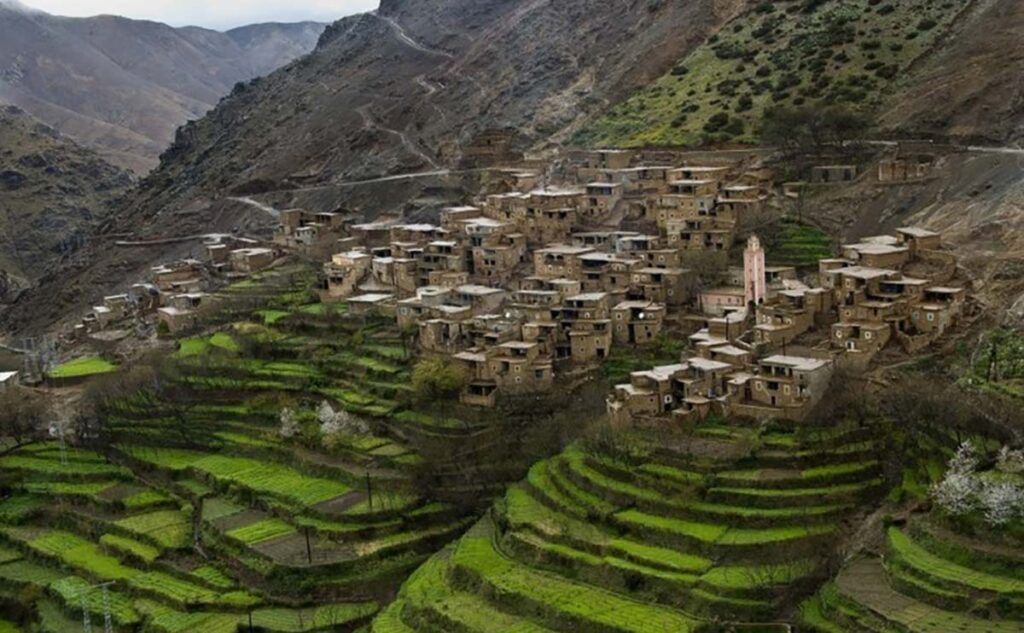
Traditional Crops: A Bounty from the Land:
Berber farmers cultivate a diverse array of crops tailored to the specific needs of their regions. Barley and wheat thrive in the higher altitudes, while olives, figs, and citrus fruits flourish in the more temperate valleys. Cultivating indigenous grains like couscous wheat is a means of sustenance and a celebration of the rich agricultural heritage embedded in Berber communities.
Irrigation Systems: Nurturing Life in Arid Lands:
Berber communities have ingeniously harnessed water in arid regions through intricate irrigation systems. Khattarat, underground tunnels that transport water from distant sources to agricultural fields, exemplify the mastery of water management. These ancient systems showcase the ingenuity required to cultivate the land in harmony with North Africa’s climate challenges.
Nomadic Herding: Symbiosis with the Land:
Nomadic Berbers engage in herding as a crucial component of their livelihoods. Goats, sheep, and camels are herded across vast landscapes for grazing grounds. This nomadic herding lifestyle provides sustenance through meat and dairy products. It allows for a dynamic relationship with the land, adapting to seasonal changes.
Impact of Modernization: Changing Landscapes:
The advent of modernization has brought both opportunities and challenges to Berber agriculture. Increased access to technology, market networks, and agricultural innovations has the potential to enhance productivity. However, modernization also threatens traditional practices, as mechanization and changes in land use can alter the delicate balance between farming and the environment.
Shifts in Livelihoods: From Agriculture to Diversification:
As Berber communities navigate modernization, there is a discernible shift from a predominantly agricultural livelihood to more diversified economic activities. Some individuals engage in tourism-related ventures like the most popular Atlas Mountains trekking tours, artisanal crafts, or services that cater to the changing needs of a globalized world. This diversification reflects a pragmatic response to the economic shifts within and beyond Berber communities.
Conservation Challenges: Balancing Tradition and Sustainability:
Conserving traditional farming practices faces challenges in the wake of modern agricultural techniques. Intensive farming, deforestation, and changes in land use patterns can strain the delicate ecosystems that have sustained Berber agriculture for generations. Balancing the preservation of tradition with sustainable agricultural practices becomes a critical endeavor.
Preserving Heritage: Sustainable Agriculture Initiatives:
Efforts are underway to integrate sustainable agricultural practices with traditional wisdom. Initiatives promoting organic farming, water conservation, and agroecological principles aim to preserve the heritage of Berber agriculture while adapting to contemporary challenges. These endeavors highlight the importance of fostering a balance that sustains Berber communities’ livelihoods and their ecosystems.
Embark on a journey through the terraced fields, orchards, and grazing lands of Berber agriculture, where the ancient cultivation traditions encounter the winds of modernization. Amid this dynamic landscape, witness Berber livelihoods’ resilience, cultivating crops and a sustainable legacy deeply rooted in their homeland.
Berber Tribes and Clans: A Mosaic of Cultural Diversity
Across the vast landscapes of North Africa, the Berber people are not a monolithic entity but a tapestry woven from numerous tribes and clans, each with its unique identity, traditions, and histories. This overview provides a glimpse into some prominent Berber tribes. It explores the dynamic interactions and relationships that define the mosaic of Berber cultural diversity.
1. Imazighen (Amazigh): The Collective Identity:
“Imazighen” or “Amazigh” serves as a collective identity for the Berber people. This overarching label encompasses tribes and clans with common linguistic and cultural elements. While unity is found in the Amazigh language and cultural practices, the diverse tribal affiliations add richness to the overall Berber identity.
2. Kabyles: Guardians of the Mountains:
The Kabyles, residing predominantly in the mountainous regions of the Kabylie region in Algeria, form one of the largest and most well-known Berber groups. Renowned for their distinct language (Tamazight) and strong ties to their ancestral lands, the Kabyles have historically played a significant role in Berber identity and resistance against external influences.
3. Riffians: Coastal Guardians in Morocco:
The Riffians are another prominent Berber group situated in the rugged Rif Mountains of Northern Morocco. The Riffians have preserved their identity despite historical challenges because of their resilience and distinct cultural practices. The region has been a stronghold of Berber resistance and a bastion of traditional ways of life.
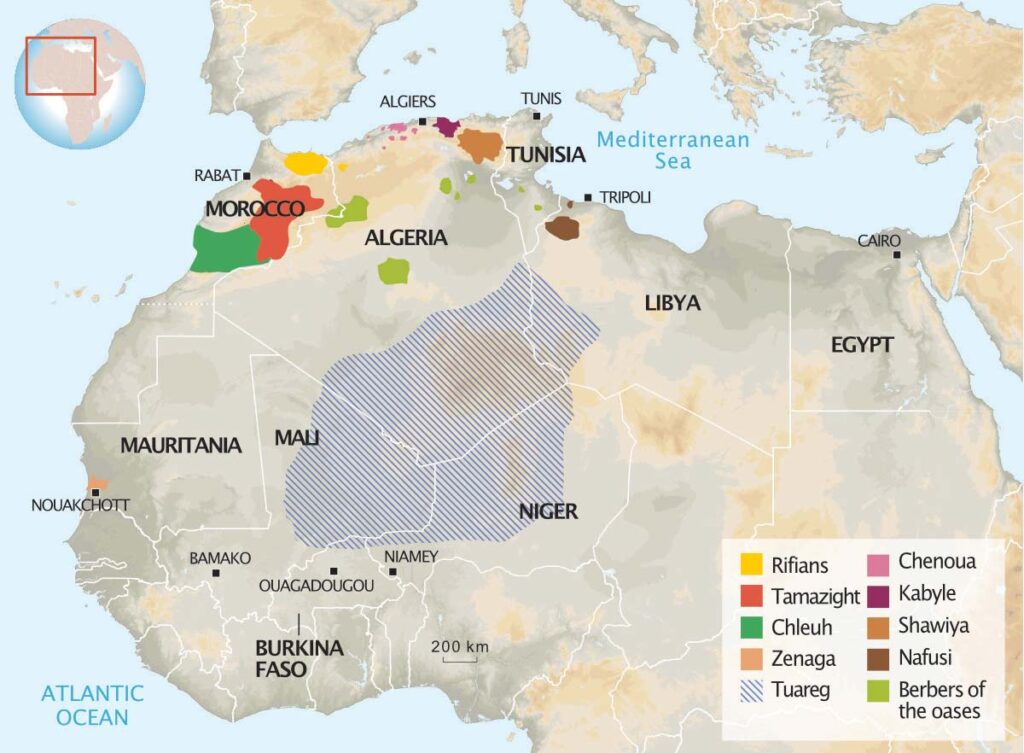
4. Tuareg: Nomads of the Sahara:
The Tuareg, also known as the “Blue Men of the Sahara” due to their indigo-dyed clothing, are nomadic Berbers who traverse the vast expanses of the Sahara Desert. Renowned for their expertise in desert survival, the Tuareg have historically engaged in trans-Saharan trade and maintained a unique social structure.
5. Chaouis: Eastern Highland Dwellers:
Residing in the Aurès Mountains of Eastern Algeria, the Chaouis form a significant Berber group known for their agricultural practices and distinct dialects. The mountainous terrain has shaped their way of life, influencing traditional practices and communal bonds.
6. Chleuhs: Highland Dwellers of the Atlas:
The Chleuhs, situated in the High Atlas Mountains of Morocco, represent a diverse group of Berbers with various sub-tribes. Known for their agricultural practices and unique dialects, the Chleuhs have maintained a solid connection to their ancestral lands.
Interactions and Relationships: Dynamics of Diversity:
A complex interplay of historical, geographic, and cultural factors shapes interactions among Berber tribes and clans. While each group maintains its unique identity, interactions often involve trade, intermarriage, and shared cultural practices. The intricate web of relationships fosters a sense of collective Berber identity while allowing for the preservation of distinct tribal traditions.
Challenges and Unity: Navigating Modern Realities:
Modernization, geopolitical changes, and socio-economic shifts have introduced new dynamics to Berber tribal relationships. Challenges such as resource competition and political changes can impact the traditional ways of life. However, shared linguistic and cultural ties often serve as a unifying force, allowing Berber communities to navigate these challenges while preserving their diverse identities.
Cultural Festivals and Gatherings: Celebrating Unity in Diversity:
Cultural festivals and gatherings provide platforms for Berber tribes to celebrate their shared heritage. Events like the Amazigh New Year (Yennayer) and other communal celebrations become spaces where diverse Berber groups unite, reinforcing a sense of unity amid their cultural diversity.
Embark on a journey through the diverse landscapes of Berber tribes and clans, where each group contributes to the rich tapestry of Berber identity. In the valleys, mountains, and oases, witness the dynamic interactions and relationships that define the mosaic of Berber cultural diversity. This mosaic continues to evolve while honoring the ancestral threads that connect these resilient communities.
Preservation of Berber Heritage: Nurturing Roots, Sowing Seeds of Cultural Continuity
Amid the shifting sands of time, the Berber people embark on a collective journey to preserve and promote their rich cultural heritage. Efforts and initiatives, driven by individuals and communities, stand as pillars of resilience in the face of challenges and opportunities that shape the destiny of Berber culture.
Cultural Documentation: Archiving the Legacy:
The preservation of Berber heritage begins with meticulously documenting cultural practices, languages, and oral traditions. Scholars, cultural organizations, and community leaders inspired by institutions like the Bert Flint Tiskiwin Museum and the Pierre Berger Berber Art Museum in Majorelle Garden engage in the recording of folklore, rituals, and historical narratives. This archival work ensures that the depth and diversity of Berber culture are safeguarded for future generations.
Language Revitalization: Sustaining Tamazight:
Tamazight, the Berber language, is a cornerstone of cultural identity. Language revitalization efforts, reminiscent of the linguistic preservation at the Tiskiwin Museum, include educational programs, publishing initiatives, and media campaigns to promote literacy and encourage using Tamazight in daily life. Bilingual education and the inclusion of Tamazight in official documents contribute to preserving linguistic diversity.
Cultural Festivals: Celebrations of Identity:
Cultural festivals, such as Yennayer (Berber New Year) and various regional celebrations, are vibrant expressions of Berber identity. These festivals unite communities, showcasing traditional music, dance, crafts, and culinary arts. The collective celebration of Berber heritage fosters a sense of belonging and pride, echoing the ethos found in the Majorelle Garden’s Berber Art Museum.
Artisanal Crafts: Reviving Traditional Skills:
The revival of artisanal crafts plays a crucial role in preserving Berber heritage, mirroring the dedication in the Majorelle Garden. Initiatives supporting local artisans and traditional craftsmanship contribute to continuing skills passed down through generations. Berber rugs, pottery, jewelry, and textiles become tangible expressions of cultural continuity, linking the past with the present.
Cultural Education: Nurturing Future Custodians:
Educational initiatives focus on integrating Berber culture into school curricula, ensuring that younger generations intensely appreciate their heritage. Cultural education programs, workshops, and storytelling sessions create spaces for dialogue between elders and youth, fostering a sense of pride and connection to Berber traditions.
Community-led Initiatives: Grassroots Resilience:
Community-led initiatives are at the heart of cultural preservation, akin to those found in the Majorelle Garden. Local associations, cooperatives, and cultural centers are pivotal in initiating projects promoting Berber culture. From establishing libraries to organizing community events, these grassroots efforts become essential in nurturing cultural resilience.
Challenges in Cultural Preservation: Navigating Modern Pressures:
While the commitment to preserving Berber heritage is unwavering, challenges persist. Modernization, urbanization, and economic pressures can erode traditional practices and values. The lure of globalized influences poses a delicate balance between embracing change and safeguarding the authenticity of Berber culture.
Opportunities in Innovation: Adapting Tradition to the Future:
In the face of challenges, opportunities for innovation emerge. Technology and online platforms, like those implemented by Marrakech Desert Trips, provide new avenues for cultural expression and outreach. Virtual museums, digital archives, and social media campaigns become tools for connecting Berber communities globally and engaging a broader audience to appreciate their heritage.
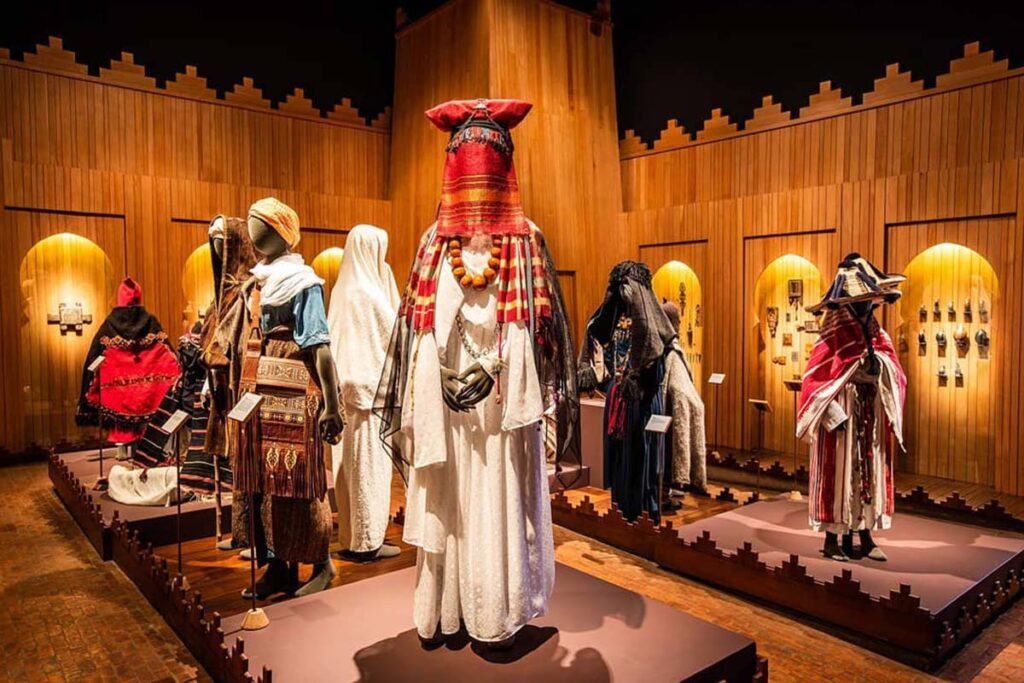
Sustainable Tourism: Balancing Preservation and Exposure:
Sustainable tourism initiatives, as exemplified by the responsible practices implemented by Marrakech Desert Trips, aim to balance cultural preservation and economic opportunities. Responsible tourism practices emphasize the importance of respecting local traditions, supporting community-led initiatives, and fostering an understanding of Berber culture among visitors without compromising its integrity.
Global Solidarity: Networking for Cultural Sustainability:
Berber communities find solidarity on a global scale through networking and collaboration, much like the global connections fostered by initiatives such as the Majorelle Garden. Partnerships with international organizations, cultural exchange programs, and participation in global forums contribute to a shared commitment to cultural sustainability. The interconnectedness of Berber communities worldwide becomes a source of strength in preserving their heritage.
In the heartlands of North Africa, the Berber people carry a cultural legacy that spans centuries—a tapestry woven with threads of tradition, resilience, and a profound connection to the landscapes they call home. From the terraced fields of agriculture to the nomadic rhythms of the Sahara, from the vibrant celebrations of cultural festivals to the harmonies of Berber music echoing through mountainous valleys, the Berber heritage is a dynamic expression of identity that endures amidst the winds of change.
Efforts to preserve and promote Berber culture emerge as beacons of hope, reflecting a collective commitment to nurturing roots and sowing seeds of cultural continuity. Archiving traditions, revitalizing language, celebrating festivals, and sustaining artisanal crafts become the building blocks of a cultural resilience that adapts to the challenges of modernization while holding steadfast to the authenticity of Berber identity.
Yet, the journey of cultural preservation is not without its complexities. Berber communities navigate the delicate balance between tradition and change, drawing upon global networks, innovative technologies, and sustainable tourism to weave a tapestry that remains true to its heritage while embracing future opportunities.
As the Berber people navigate the shifting sands of time, their journey becomes a testament to the enduring spirit of a culture deeply rooted in the landscapes, traditions, and stories passed down through generations. The vibrant mosaic of Berber tribes and clans, the rhythmic tales of nomadic life, and the melodies and dances that echo through the mountains—all contribute to a cultural richness that transcends borders and resonates across the diverse landscapes of North Africa.
In conclusion, preserving Berber heritage is not merely a task; it is a celebration of identity, a commitment to continuity, and a testament to the resilience of a people whose cultural legacy is woven into the very fabric of the landscapes they inhabit. As Berber communities embrace the future while honoring their past, the story of their heritage continues to unfold—a story that invites the world to appreciate the beauty and depth of Berber culture, a story that echoes through the ages, carrying the voices of a people proud of their roots and bound by the enduring threads of their cultural tapestry.



